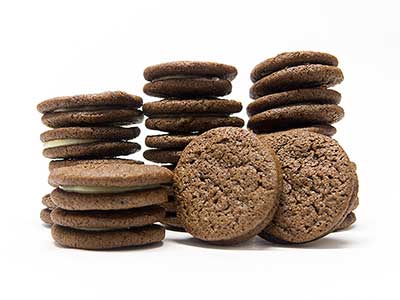September 15, 2014
Mignardise

biscuits « Oreo »
(“Oreo” cookies)
In 1824, Charles Caleb Colton wrote: “Imitation is the sincerest [form] of flattery,” and we’ve been stuck ever since with similar phrases to excuse our copying the work of others. In my estimation, no other field has as much copying as cooking. Whether imitating, duplicating, mimicking, simulating, or outright plagiarizing, to say that copying isn’t commonplace in cooking is to deny that the sun rises in the east and sets in the west. (That line sounds copied to me!)
Like all people that cook and create, my ideas often come from eating and experiencing dishes created by others. For most cooks, all they need to do is to add an ingredient or two and or make the instructions more complicated. They now have a recipe that they claim is their own. I pride myself on doing the opposite: I reduce the number of ingredients and simplify the instructions before claiming the recipe as mine. In the end, the line between being inspired by and copying a dish or recipe can be a bit fuzzy.
Enter Oreo cookies. The “Oreo Biscuit” was introduced in 1912 by the National Biscuit Company as an imitation of the Hydrox cookie baked by Sunshine Biscuits. And the copying continues. Google the phrase “oreo cookie recipes” and almost two million pages are returned. I found the recipe I used back in the fall of 2011 while I was surfing the web looking for something else. It turns out that recipe was copied from this recipe, which in turn was copied from this one. This one appeared to be original until I read the fine print.
Since my interest is mignardise, I only made about half a recipe and still had between 30 and 36 finished cookies. I worked with metric units and then converted the results to English units. It turns out my numbers disagree with the “original” recipe.
For the filling, I used homemade “sweetened condensed milk” left over from the Martha Washington’s recipe. My wife suggested using a cream-cheese frosting such you typically find on carrot cake. That would be good. Or use the filling recipe from one of the links given above.
90 g (5⁄8 c)
all-purpose flour
30 g (1⁄4 c)
natural (not Dutch-processed) cocoa powder
1⁄2 t
baking soda
1⁄4 t
baking powder
1⁄8 t
fine salt
100 g (1⁄2 c)
finely granulated sugar
70 g (5 T)
unsalted butter, at room temperature
25 g (about 1⁄2 large)
beaten egg
filing of choice
1. If any of your dry ingredients have any lumps—cocoa powder often does—sift all the dry ingredients together into a bowl. Whisk the butter and beaten egg together in a separate bowl until the butter pieces are very small and evenly dispersed. Add the liquids to the dry ingredients. Mix with a rubber spatula until a smooth, dark-brown dough is achieved. This can take a number of minutes.
2. Divide the dough into two portions. Roll each portion into a log that is about 2-1⁄2 cm (1 in) in diameter. Wrap each in plastic wrap, and set into your refrigerator until quite firm.
3. Preheat oven to 190 °C (375 °F). Prepare two rimmed baking sheets with silicone mats or parchment paper.
4. Working with one dough log at a time, remove and discard the plastic wrap. Using a thin knife and a long slicing motion, cut the dough into 6-mm (1⁄4-in) thick slices. Arrange the slices—which don’t have to be absolutely round—on a prepared baking sheet so that the cookies are spaced about 5 cm (2 in) apart.
5. Bake for 9 minutes.
6. Leave the cookies on the baking sheet until they firm up. Then transfer to a cooling rack.
7. When cool, assemble pairs of cookies into sandwiches with the filling in between.
© 2014 Peter Hertzmann. All rights reserved.
